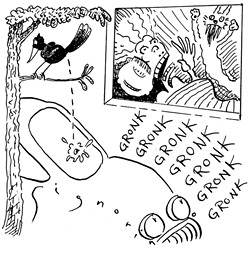What is it with car alarms? They go off 24/7 for any or no reason to create a constant urban din. Do they deter any thefts, are they required by law, or are they just a way to lard on the features? —Samuel Press, shell-shocked in Vermont
Listen, Samuel, if you're tormented by the constant urban din of Vermont, you've got a pretty low annoyance threshold. I'm going to work on the assumption you're a refugee from New York City, where historically car alarms have been more of an issue (although speaking as a big-city habitué I'd say this is one irritant that may have crested a good 20 years ago). Browsing on the interwebs, I found a claim from back in 2003 that noisy car alarms cost New Yorkers $400 million annually, based on an ingenious but basically harebrained calculation of the extent to which car alarms diminish the quality of life for those in hearing range. One wants to say: Suck it up, crybabies. Admittedly, that's the attitude of someone not currently being driven bats by a blaring alarm, and one wants to be supportive of one's fellow city dwellers. So here's the best case I can make for why car alarms should be banned.
1. Car alarms have middling, but certainly some, effectiveness as a theft deterrent, research suggests. We learn this from Farrell et al (2010), who use the straightforward method of comparing (a) the number of cars with a given antitheft technology against (b) the number of cars with that technology that get stolen. Sixty-three percent of cars have alarms, we learn (based on U.K. data), whereas only 41 percent of stolen cars have alarms. Forty-one is 35 percent less than 63. Ergo, car alarms are 35 percent effective in deterring theft.
2. This is considerably less potent than what Farrell's numbers suggest is the single most effective antitheft measure, namely a tracking device on your car that lets the cops (or you) determine its whereabouts if bad guys abscond with it. Effectiveness: 77 percent.
3. On the other hand, car alarms work better than the most common antitheft measure nowadays, central locking (powered door locks controlled by a button on the key or fob)—32 percent effective. And they're way better than window security etching (inscribing the vehicle ID number on the glass), 14 percent, or mechanical steering-wheel locks, 7 percent. In fact, cars with the latter two antitheft measures experience more theft attempts, leading one to wonder what exactly the detailers are inscribing on those windows: "Bet you can't steal this car?"
4. This is off the track of my argument, but since you asked, car alarms aren't required in the U.S., and I haven't heard of them being required elsewhere. Canada, Australia, and many European countries require "electronic immobilization"—put simply, ignition kill switches. Are alarms and such an excuse to add on extras? I suppose, but the common view is that the real security ripoff isn't an alarm, it's window etching.
5. Up to this point things aren't looking good for the anti-car-alarm crusade. No worries. The question of interest isn't whether car alarms work, but whether other less obnoxious technologies work as well or better. Answer: absolutely. As we've seen, vehicle-tracking devices are the most effective antitheft measure, and it appears combinations of measures are more effective yet.
6. To quantify the efficaciousness of vehicle antitheft devices, Farrell and friends in a 2011 paper presented a metric they called "security protection factor," or SPF, along the lines of the scheme used to rate sunscreen. The higher the SPF the better; a car having an antitheft device or devices with an SPF of 10 is ten times less likely to be stolen than a car having no security.
7. A car alarm all by itself, according to Farrell and company, has an SPF of just 1.2, whereas central locking is rated 2.7. (This appears to contradict the results reported in paragraph 3 for reasons not explained—ask Farrell.) But an alarm plus central locking has an SPF of 5. Pile on the technologies and the multiplier effect becomes more pronounced. At the top of Farrell's list of antitheft technologies, with an SPF of 25.4, is the following fourplex: central locking plus an ignition kill-switch plus a tracking device plus, yes, an alarm. Farrell calls this the ACET configuration.
8. This isn't helping, you say. Patience. A close second on the list of efficacious antitheft packages, with a 25.2 SPF, is central locking plus an ignition kill switch plus a steering-wheel lock but no damn alarm—the CEM configuration, in Farrell argot.
9. There's your opening, alarm haters—you can get equivalent protection without the racket. Understand, we're talking strictly about theft of the car; separate SPF ratings are calculated for protection against theft of a car's contents. In the latter category ACET trounces CEM 6.6 to 2.5—a noisy alarm offers more protection against somebody stealing a car stereo. What's more important, though—your stereo or your neighbors' sanity? We'll have to give that some thought. But at least there's an argument to be made.
Send questions to Cecil via StraightDope.com or write him c/o Chicago Reader, 350 N. Orleans, Chicago 60654.
More by Cecil Adams
-
This Is the End, My Friend
This week's Straight Dope marks the last appearance of the column as the Teeming Millions have known it for the past 45 years.
- Jul 11, 2018
-
Do Brain Supplements Do Anything?
Brain Drain
- Jul 4, 2018
-
Is flying really worse for the environment than driving?
Planes and Trains
- Jun 27, 2018
- More »




